Apple powermac g3 Service Manual

K Service Source
Power Macintosh G3
All-In-One

K Service Source
Basics
Power Macintosh G3
All-In-One
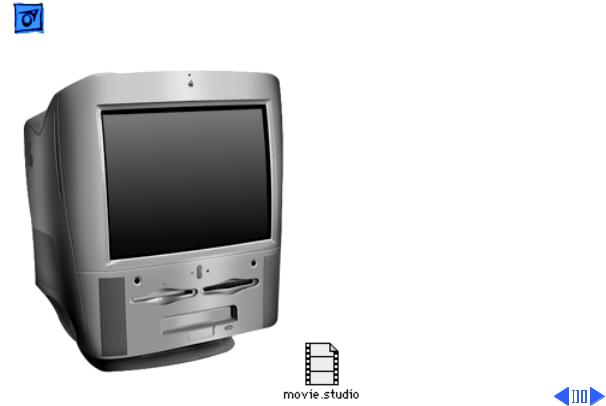
Basics |
Overview - 1 |
|
|
|
|
Overview
Introducing the Power Macintosh G3 All-In-One design.
• The new all-in-one is designed for education and fulfills all the computing needs of teachers and students.
• Powerful and easy-to-use video editing and multimedia authoring features at an affordable price.
Click the icon at left for a
QuickTime VR movie of the
Power Mac G3 All-In-One.

Basics |
Overview - 2 |
|
|
|
|
|
Features of the Power Macintosh G3 All-In-One include |
|
|
• PowerPC G3 microprocessor running at 233 MHz or |
|
|
266 MHz |
|
|
• RAM expandable to 384 MB in 3 DIMM slots using 64- |
|
|
bit wide, 168-pin JEDEC-standard 3.3 V unbuffered |
|
|
SDRAM DIMMs |
|
|
• 512K of static RAM used as L2 cache on processor module |
|
|
• Built-in 2D and 3D hardware graphics acceleration |
|
|
• PERCH slot to support I/O card |
|
|
• One modem slot on the I/O card for optional fax/modem |
|
|
card |
|
|
• 4 GB or 6 GB ATA hard drive |
|
|
• 100 MB SCSI Iomega Zip drive |
|
|
• CD-ROM ATAPI drive at 24X speed |
|
|
• 1.4 MB SuperDrive |
|
|
• One SCSI port |
|
|
• Two GeoPort serial ports |
|
|
• 10BASE-T Ethernet port |
|

Basics |
Overview - 3 |
|
|
|
|
|
• One ADB port |
|
|
• Three PCI expansion slots to accept |
|
|
• three 7-inch PCI cards, or |
|
|
• three 15 W cards, or |
|
|
• two 25 W cards, or |
|
|
• one 15 W card and one 25 W card |
|
|
• Fan speed thermally controlled |
|
|
• Energy Saver control panel |
|
|
• 2 MB video RAM expandable to 6 MB with |
|
|
3.3 V, 100 MHz or faster SGRAM on a 144-pin small |
|
|
outline dual inline memory module (SO-DIMM) |
|

 Basics Overview - 4
Basics Overview - 4
Optional Build-to-Order Power Mac All-In-One Features:
• 100 MB SCSI Iomega Zip drive in the expansion bay
• 6 GB hard drive
• 64 MB (using one 64 MB DIMM) or 96 MB (using 1x 32 MB and 1x64 MB DIMM) of memory
• I/O, Audio/Video card
• 10/100 BaseT ethernet card

 Basics The Cuda Chip - 5
Basics The Cuda Chip - 5
The Cuda Chip
The Cuda is a microcontroller chip. Its function is to
• Turn system power on and off
• Manage system resets from various commands
• Maintain parameter RAM (PRAM)
• Manage the Apple Desktop Bus (ADB)
• Manage the real-time clock
Many system problems can be resolved by resetting the Cuda chip (see Symptom Charts for examples). Press the Cuda reset button on the logic board to reset the Cuda chip. (See “Logic Board Diagram” later in this chapter to locate the Cuda reset button.) If you continue to experience system problems, refer to “Resetting the Logic Board” in this Basics chapter.

Basics |
Resetting the Logic Board - 6 |
|
|
|
|
Resetting the Logic Board
Resetting the logic board can resolve many system problems (refer to “Symptom Charts” for examples). Whenever you have a unit that fails to power up, you should follow this procedure before replacing any modules.
1Unplug the computer.
2Remove the battery from the logic board.
3Disconnect the power supply cable from the logic board and then press the Cuda Reset button. (See “Logic Board Diagram” later in this chapter to locate the Cuda Reset button.)
4Wait at least 10 minutes before replacing the battery.
5Make sure the battery is installed in the correct +/- direction.

Basics |
Resetting the Logic Board - 7 |
|||
|
|
|
||
|
6 Reassemble the computer and test the unit. |
|||
|
Note: This procedure resets the computer’s PRAM. Be sure |
|||
|
to check the computer’s time/date and other system |
|||
|
parameter settings afterwards. |
|||
|
|
|
|
|
|
|
|
|
|

Basics |
Sound - 8 |
|
|
|
|
Sound
The sound system for the Power Macintosh G3 computers is implemented entirely on the I/O card. Each supports 16-bit stereo sound output and input, available simultaneously.
The sound circuitry on the I/O card and system software can create sounds digitally and either play the sounds through speakers inside the enclosure or send the sound signals out through the sound output jacks. The sound circuitry digitizes and records sound as 16-bit samples. The computer can use 22.050K or 44.100K samples per second. The sound system plays samples at the sampling rate specified in the Monitors & Sound control panel.

Basics |
Sound - 9 |
|
|
|
|
|
The Power Macintosh G3 also records sound from several |
|
|
sources: |
|
|
• A microphone connected to the line-level sound input |
|
|
jack |
|
|
• A compact disc in the CD-ROM player |
|
|
• Analog sound from the cross-platform card in a PCI slot |
|
|
• Analog sound from optional communication cards |
|
|
• Internal Microphone |
|
|
With each sound input source, sound playthrough can be |
|
|
enabled or disabled. |
|

Basics |
Sound - 10 |
|
|
|
|
Sound Output
All sound output features for the Power Macintosh G3 computer are provided by the I/O card. The I/O card provides one mini jack for sound output on the back of the enclosure.
The output jacks are connected to the sound amplifier. The mini jack is intended for connecting a pair of headphones or amplified external speakers. There are two speakers and two headphone jacks on the front of the system. Inserting a plug into the sound output mini jack disconnects the internal speaker.

Basics |
Sound - 11 |
|
|
|
|
Sound Input
The I/O card provides a stereo sound input jack on the back of the enclosure for connecting an external Apple PlainTalk line-level microphone or other sound source pair of linelevel signals. The sound input jack accepts a standard 1/8- inch stereophonic phone plug (two signals plus ground).
Note: The microphone for the Macintosh LC and LC II does not work with the I/O cards.
Options in the Monitors & Sound control panel determine the interaction between the sound input and output devices. The sound circuitry normally operates in one of three modes:
• Sound playback—computer-generated sound is sent to the speaker and the sound output jacks.
• Sound playback with playthrough—computer sound and sound input are mixed and sent to the speakers and sound output jacks.

Basics |
Sound - 12 |
|
|
|
|
|
• Sound record with playthrough—input sound is recorded |
|
|
and also sent to the speakers and sound output jacks. |
|

Basics |
PowerPC G3 and Backside Cache - 13 |
|
|
|
|
PowerPC G3 and Backside Cache
Backside cache is a significant architectural design change from earlier PowerPC processors. The main advantage of the backside cache architecture is the speed of the dedicated CPU-to-L2 cache interface. Using the dedicated bus allows the CPU to access the fast L2 cache storage through a high speed bus without addressing the slower system bus or competing with other devices attached to the system bus. In comparison, a “far-side” cache running on the system bus would limit that SRAM interface to 50MHz.
The PowerPC G3 microprocessor interfaces with SRAM storage via a dedicated bus running at various multiples of the core PLL CPU speed. With high speed L2 SRAM and a dedicated L2 bus, the CPU can access stored information up to the speed of the processor clock. L2 access is determined by the clock ratio setting. For example, with a 250MHz

Basics |
SDRAM DIMMs - 14 |
|
|
|
|
|
PowerPC G3, and a 2.5 L2 bus ratio, the backside cache bus |
|
|
speed will be 100MHz, twice the speed of the system bus. |
|
SDRAM DIMMs
Three DRAM expansion slots on the logic board accept 3.3 V SDRAM unbuffered 8-byte DIMMs. The 168-pin DIMM has a 64-bit-wide data bus per bank. The minimum bank size supported on the Power Macintosh G3 all-in-one model is 4 MB, and the largest is 64 MB. The largest DIMM supported is a two-bank DIMM of 64 MB using 32 Mbit SDRAM devices.
The Power Macintosh G3 All-In-One logic board supports a maximum DRAM expansion of 384 MB. Fill all three slots with 128 MB DIMMs.

Basics |
SDRAM DIMMs - 15 |
|||
|
|
|
||
|
The DRAM DIMMs can be installed one or more at a time. The |
|||
|
logic board supports only linear memory organization. |
|||
|
Therefore, no performance gains are seen when two DIMMs |
|||
|
of the same size are installed. Any supported size DIMM can |
|||
|
be installed in any DIMM slot, and the combined memory of |
|||
|
all the DIMMs installed will be configured as a contiguous |
|||
|
array of memory. |
|||
|
Important: Power Macintosh G3 computers use SDRAM |
|||
|
DIMMs. DIMMs from older Macintosh computers are not |
|||
|
compatible and should not be used even though they fit into |
|||
|
the DRAM DIMM slots. |
|||
|
|
|
|
|
|
|
|
|
|

Basics |
SGRAM Video Memory - 16 |
|
|
|
|
SGRAM Video Memory
The Power Macintosh G3 logic board comes with 2 MB of Synchronous Graphic RAM (SGRAM) video memory soldered on. The logic board also contains a video memory expansion slot that accepts a Small Outline DIMM (SO-DIMM) to increase video memory up to a maximum of 6 MB. Apple supports a 4 MB SGRAM SO-DIMM that is 32-bit wide, 144-pin, fast-paged, 100 MHz/10 ns cycle time or faster.
Important: Use only SGRAM SO-DIMMs. Never use the 256K or 512K video memory DIMMs used in older Macintosh computers.

Basics |
|
|
|
|
|
|
|
|
|
|
|
|
|
|
|
|
|
|
|
|
|
|
|
|
|
DIMM Slots - 17 |
|||
|
|
|
|
|
|
|
|
|
|
|
|
|
|
|
|
|
|
|
|
|
|
|
|
|
|
|
|
|
|
|
DIMM Slots |
|
|
|
|
|
|
|
|
|
|
|
|
|
|
|
|
|
|
||||||||||
|
|
DRAM |
|
|
|
|
|
ROM Slot |
|||||||||||||||||||||
|
|
DIMM |
|
|
|
|
|
||||||||||||||||||||||
|
|
|
|
|
|
|
(Do not remove |
||||||||||||||||||||||
|
|
Slots |
|
|
|
|
|
||||||||||||||||||||||
|
|
|
|
|
|
|
the ROM DIMM.) |
||||||||||||||||||||||
|
|
|
|
|
|
|
|
|
|
|
|
|
|
|
|
|
|||||||||||||
|
|
|
|
|
|
|
|
|
|
|
|
|
|
|
|
|
|
|
|
|
|
|
|
|
|
|
|
|
|
|
|
|
|
|
|
|
|
|
|
|
|
|
|
|
|
|
|
|
|
|
|
|
|
|
|
|
|
|
|
|
|
|
|
|
|
|
|
|
|
|
|
|
|
|
|
|
|
|
|
|
|
|
|
|
|
|
|
|
|
|
|
|
|
|
|
|
|
|
|
|
|
|
|
|
|
|
|
|
|
|
|
|
|
|
|
|
|
|
|
|
|
|
|
|
|
|
|
|
|
|
|
|
|
|
|
|
|
|
|
|
|
|
|
|
|
|
|
|
|
|
|
|
|
|
|
|
|
|
|
|
|
|
|
|
|
|
|
|
|
|
|
|
|
|
|
|
|
|
|
|
|
|
|
|
|
|
|
|
|
|
|
|
|
|
|
|
|
|
|
|
|
|
|
|
|
|
|
|
|
|
|
|
|
|
|
|
|
|
|
|
|
|
|
|
|
|
|
|
|
|
|
|
|
|
|
|
|
|
|
|
|
|
|
|
|
|
|
|
|
|
|
|
|
|
|
|
|
|
|
|
|
|
|
|
|
|
|
|
|
|
|
|
|
|
|
|
|
|
|
|
|
|
|
|
|
|
|
|
|
|
|
|
|
|
|
|
|
|
|
|
|
|
|
|
|
|
|
|
|
|
|
|
|
|
|
|
|
|
|
|
|
|
|
|
|
|
|
|
|
|
|
|
|
|
|
|
|
|
|
|
|
|
|
|
|
|
|
|
|
|
|
|
|
|
|
|
|
|
|
Video Memory Expansion Slot
SGRAM SO-DIMM

Basics |
- 18 |
|
|
|
|
Peripheral Component Interconnect
(PCI)
The Peripheral component Interconnect (PCI) expansion slots accept 7-inch PCI cards. Install only expansion cards that come with Macintosh drivers and are compliant with the PCI 2.1 standard. Nubus™ cards cannot be used in these expansion slots.
PCI offers significantly higher performance than the NuBus architecture used in previous Macintosh models. Running at 33 MHz, the PCI bus is up to three times faster than NuBus, offering overall enhanced system performance, particularly in the areas of video and networking.
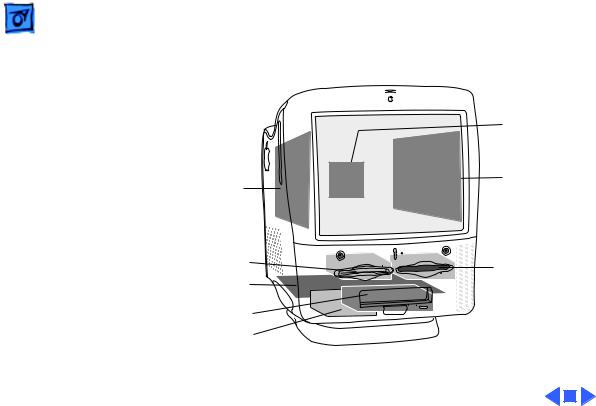
Basics |
Internal Locator - 19 |
|
|
|
|
Internal Locator
Video Board
Power Supply
Analog Board
Zip Drive |
Floppy Drive |
|
|
Logic Board |
|
CD-ROM Drive |
|
Hard Drive |
|
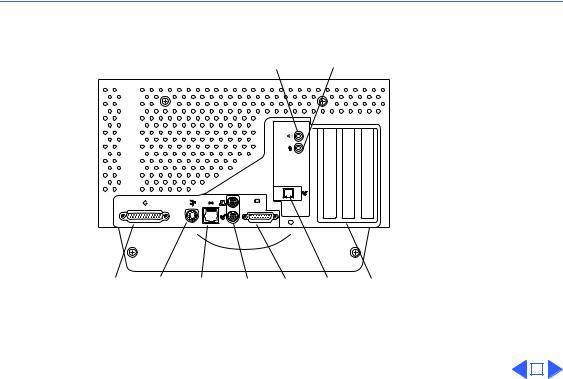
 Basics Rear View - 20
Basics Rear View - 20
Rear View
Sound Output Port |
Sound Input Port |
|
See next page for |
|
optional AV card. |
SCSI Apple |
Ethernet |
Printer Monitor Internal |
Access |
|
|
Port Desktop (10Base-T) & |
Port Modem |
Covers for |
|
||
Bus |
Port |
External |
Card |
Expansion |
|
(ADB) |
|
modem |
Port |
Slots (3) |
|
Port |
|
Port |
|
|
|
|
|
|
|
|
|
|
|
|
|
|
|
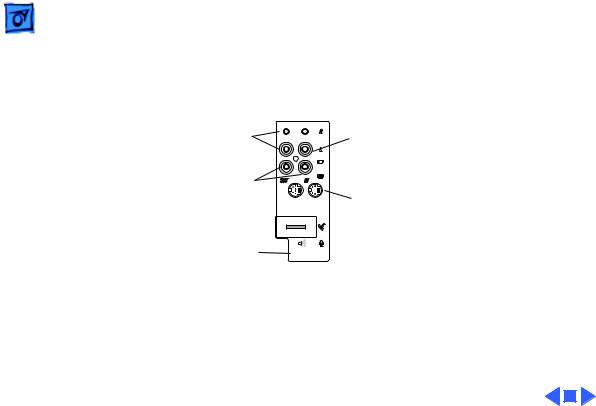
Basics |
Optional AV Card - 21 |
|
|
|
|
Optional AV Card
Audio output ports (right & left)
Composite Video Ports
(OUT and IN)
Sound Output Port




 Audio Input Ports
Audio Input Ports
(right & left)

 S-Video Ports
S-Video Ports
(OUT and IN)

 Sound Input Port
Sound Input Port
Optional AV ports
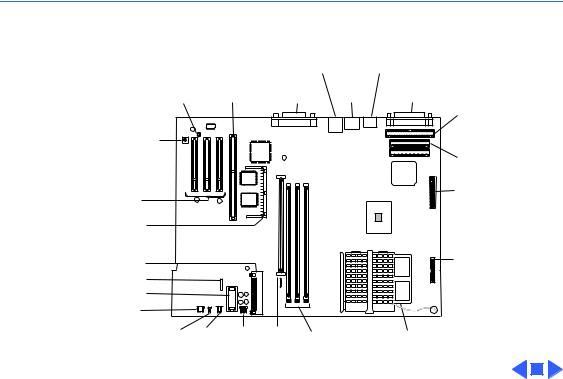
 Basics Logic Board - 22
Basics Logic Board - 22
Logic Board
|
|
Ethernet ADB |
||
|
|
Port |
|
Port |
Power Supply |
PERCH |
Monitor |
Serial |
SCSI |
Jumper Block |
Slot |
Port |
Ports |
Port |
|
Internal SCSI |
|
Cuda Reset Button |
Connector |
|
|
||
|
IDE Connector |
|
PCI |
Power Supply |
|
Slots |
||
Connector |
||
|
||
Video Memory |
|
|
SO DIMM |
|
Voltage Regulator |
|
Floppy Drive |
Processor Jumper Block |
|
Connector |
|
|
|
Battery |
|
|
LED |
|
|
Speaker Power CD ROM |
DRAM |
Microprocessor |
On/Off Audio DIMM |
DIMM |
|

Basics |
Repair Strategy - 23 |
|
|
|
|
Repair Strategy
Service the Power Macintosh G3 computers through module exchange and parts replacement. Customers can request onsite service from an Apple Authorized Service Provider Plus (AASP+), Apple Assurance (US only), or Apple Canada Technical Answerline (Cananda only). They can also choose carry-in service from an AASP.
Ordering
Apple Service Providers planning to support the computer systems covered in this manual may purchase Service modules and parts to develop servicing capability. To order parts, use the AppleOrder (US only) or ARIS (Canada only) system and refer to the Power Macintosh G3 “Service Price Pages.”

Basics |
Repair Strategy - 24 |
|
|
|
|
|
Large businesses, universities, and K-12 accounts must |
|
|
provide a purchase order on all transactions, including |
|
|
orders placed through the AppleOrder (US only) or ARIS |
|
|
(Canada only) system. |
|
USA Ordering
US Service providers not enrolled in AppleOrder may fax their orders to Service Provider Support (512-908- 8125) or mail them to
Apple Computer, Inc. Service Provider Support MS 212-SPS
Austin, TX 78714-9125
For US inquiries, please call Service Provider Support at 800-919-2775 and select option #1.

Basics |
Repair Strategy - 25 |
|
|
|
|
Canadian Ordering
Canadian Service providers not enrolled in ARIS may fax their orders to Service Provider Support in Canada (1- 800-903-5284). For Canadian inquiries, please call Service Provider Support at 905-513-5782 and select option #3.

Basics |
Warranty/AppleCare/ARIS - 26 |
|
|
|
|
Warranty/AppleCare/ARIS
US Only
The Power Macintosh G3 computers are covered under the Apple One-Year Limited Warranty. The AppleCare Service Plan is also available for these products. Service Providers are reimbursed for warranty and AppleCare repairs made to these computers. For pricing information, refer to “Service Price Pages.”
Canada Only
The Power Macintosh G3 computers are covered under AppleCare. The Extended AppleCare Service Plan is also available for these products. Service Providers are reimbursed for warranty and AppleCare repairs made to these computers. For pricing information, refer to “Service Price Pages.”

K Service Source
Specifications
Power Macintosh G3 All-in-One

Specifications |
Introduction - 1 |
|
|
|
|
Introduction
Specifications information for this product can be found in the Spec Database, which you can access at Service Source Online (http://service.info.apple.com) or on Service Source CD.
Spec Database at Service Source Online
From the Service Source Online home page, click Troubleshoot and Repair to access the main repair procedures page. Then click either Apple Spec in the navigation table in the upper right corner of the page, or click Apple Spec Database from the list of reference tools below.
Spec Database on Service Source CD
Open the CD and double-click the Apple Spec Database alias located at the top level of the CD.
